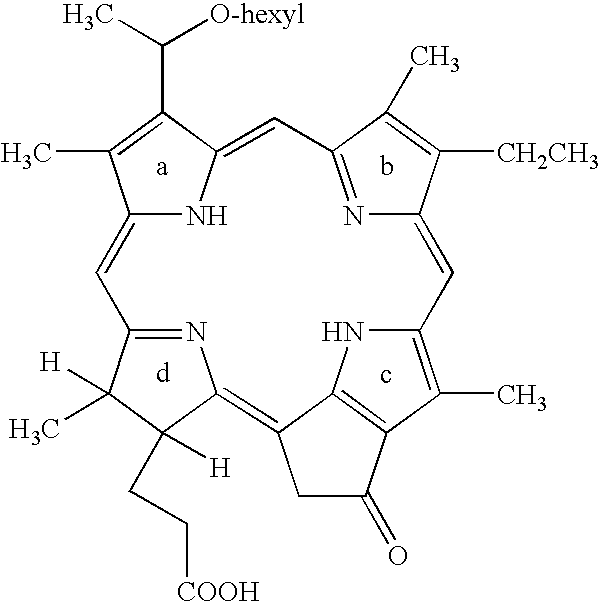Treatment of esophageal high grade dysplasia using photodynamic therapy
a high-grade dysplasia and photodynamic therapy technology, applied in the direction of biocide, heterocyclic compound active ingredients, drug compositions, etc., can solve the problems of prolonged skin phototoxicity, pain, and death of cancer-causing irritation, and achieve the effect of fewer side effects
- Summary
- Abstract
- Description
- Claims
- Application Information
AI Technical Summary
Benefits of technology
Problems solved by technology
Method used
Image
Examples
Embodiment Construction
[0017]Injection of the HHPH is preferably accomplished intravenously usually over a time period of 0.75 to 3 hours in a physiologically compatible medium. The time period is functionally dependent upon rate of infusion and dose level desired The concentration is preferably 0.5-through 1.5 mg / ml in medium and the medium is preferably 0.1% polysorbate 80, 2% ethyl alcohol and 5% glucose in normal saline.
[0018]Exposure is accomplished using a fiber optic carrying laser light emitted by a laser. The laser may be any suitable laser emitting light at the wavelength and energy desired, e.g. a dye or diode laser. Exposure may be adjusted by length of time of exposure and / or adjustment of light intensity.
[0019]Using the above parameters, a phase I / II trial using HPPH and a phase III trial using PHOTOFRIN™, the latter approved by the United States Food and Drug Administration, the following results for response of high grade dysplasia were obtained, with CR being defined as complete ablation ...
PUM
| Property | Measurement | Unit |
|---|---|---|
| time | aaaaa | aaaaa |
| wavelength | aaaaa | aaaaa |
| energy | aaaaa | aaaaa |
Abstract
Description
Claims
Application Information
 Login to View More
Login to View More - R&D
- Intellectual Property
- Life Sciences
- Materials
- Tech Scout
- Unparalleled Data Quality
- Higher Quality Content
- 60% Fewer Hallucinations
Browse by: Latest US Patents, China's latest patents, Technical Efficacy Thesaurus, Application Domain, Technology Topic, Popular Technical Reports.
© 2025 PatSnap. All rights reserved.Legal|Privacy policy|Modern Slavery Act Transparency Statement|Sitemap|About US| Contact US: help@patsnap.com

